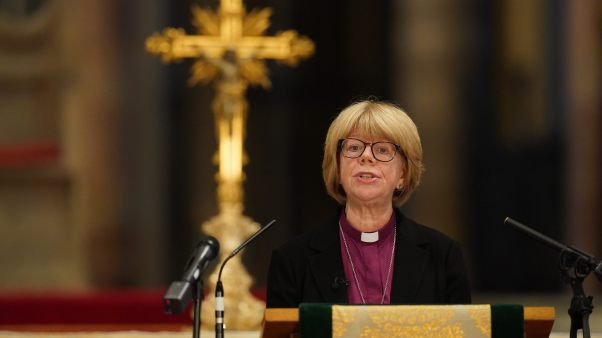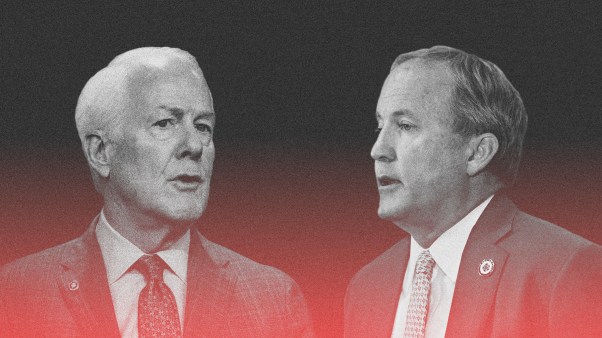They want a bigger role, but the attorney general says no.
On March 19, 1981, Arkansas became the first state ever to require the teaching of scientific creationism in public schools where evolution theory is taught. Four months later, its neighbor to the south, Louisiana, passed a similar law.
After about 15 defeats in state legislatures, creationists are celebrating these back-to-back victories. But a trial is scheduled to begin late this month in a lawsuit filed by the American Civil Liberties Union (ACLU), which wants the law declared unconstitutional.
The ACLU also has vowed to get the Louisiana law thrown out. The effort there, however, will likely take a back seat until after the Arkansas ruling. “Let Arkansas do it,” was the way a member of a Texas school board put it. That seems to be the motto, for the time being, of those considering sponsoring a creationism law—or preparing to challenge one.
Federal Judge William R. Overton will try the case, which is due to start in Little Rock on October 26. The trial is expected to take about a week.
The Arkansas chapter of the ACLU filed suit in Little Rock on behalf of 23 individuals—including about a dozen clergymen—and organizations. It contends the law violates the Constitutional separation of church and state, and that it abridges academic freedom.
The suit, filed by ACLU attorneys Philip Kaplan and Bob Cearley, alleged that creation, as used in the law, “necessarily encompasses the concept of a supernatural Creator …, an inherently religious belief. Creation-science cannot be taught without reference to that religious belief in a Creator.”
In short, the plaintiffs charged that Act 590 of 1981 is but the first two chapters of Genesis rewritten to sound scientific.
Starting in the fall of 1982, the Balanced Treatment Act, as it is formally known, requires that in public schools from grades 1 through 12, science texts and lectures that espouse evolution theory are to be “balanced” with creation-science theory. (Ironically, several science textbooks used in public schools in the state include creation theory along with evolution, but those books are not mandatory.)
“Monkey Trial II!” skeptics are shouting, a reference to the 1925 trial of John T. Scopes, a Dayton, Tennessee, high school biology teacher who was found guilty of violating a state law banning the teaching of evolution. And a circus atmosphere reminiscent of the Scopes trial is building.
Just as the infamous trial of 56 years ago had the inimitable scoffer H. L. Mencken leading the corps of reporters that telegraphed 175,000 words a day—the equivalent of two novels—out of the small Tennessee town, Little Rock has its own mass media star, albeit of a different nature.
Carl Sagan, host of the “Cosmos” television series and author of the best seller of the same title, is but one of the expert witnesses lined up by the ACLU. Others, including paleontologist Niles Eldredge, are eminently qualified in their own right, but they lack Sagan’s exposure and charisma.
Sagan, a Pulitzer Prize-winning astrophysicist, has been speaking out against the Arkansas law and creationism in general. On a recent “Tonight Show,” he told host Johnny Carson that the law is a thinly disguised reworking of the “Genesis myth.” The only way he would allow the teaching of this notion would be if it were included in a course with other fanciful tales, he told Carson.
Bruce Ennis, national legal director of the ACLU, and Kelly Segraves, director of the Creation Science Institute at San Diego, whetted the national appetite by debating the Arkansas law on the “Phil Donahue Show.” Locally, the University of Arkansas at Little Rock (UALR) revived Inherit the Wind, the play based on the famed confrontation between William Jennings Bryan and Clarence Darrow in the Scopes trial.
The law’s detractors in Arkansas have taken the banana as their symbol of protest. Created by George Fisher, political cartoonist for the Arkansas Gazette, “banana buttons” are being sold for $1, with proceeds going to the Zoo of Arkansas. Even Governor Frank White, who inspired Fisher’s campaign by signing the legislation, and who is often satirized by the cartoonist, has good-naturedly sported a button from time to time.
Whatever the similarities in the publicity surrounding the two trials, there appear to be substantial differences in the law and in the legal issues. The Tennessee law forbade teaching of evolution in contradiction of the biblical account of creation. Act 590 strictly prohibits religious instruction or even references to religious writing in requiring the “balancing” of evolutionary theory with creation science.
Scopes was tried simply on whether he had violated the law. The ACLU will attempt to prove that Act 590 violates the Constitutional rights of school children as provided in the First and Fourteenth Amendments.
Scopes was found guilty and fined, but the conviction was overturned in 1927 by the Tennessee Supreme Court, which at the same time upheld the constitutionality of the law. Decades later, the law was thrown out.
In 1929, the Arkansas legislature passed an antievolution law, which stood until 1968 when the U.S. Supreme Court struck it down. The ACLU says it is that case that parallels its current lawsuit.
Defenders of the Tennessee law were avowedly fundamentalist, and there is a strong fundamentalist/evangelical sympathy for the Arkansas statute.
However, 15 persons and four organizations, representing a diverse religious and scientific base, are seeking to intervene as codefendants with the state in favor of the law. About half are members of the scientific and medical communities. These include a group of Orthodox Jews, the Rabbinical Alliance of America, and a Muslim. They also include some of the country’s best-known creationists.
These people feel the state has not shown that it is preparing the best defense it can. They base that opinion mainly on the statements and actions of state Attorney General Steve Clark, whose job it is to defend the law in court. The day the ACLU filed suit, Clark sounded more like counsel for the plaintiffs. He expressed misgivings about the law. “My personal qualms just deal with whether it’s good for the state,” Clark told reporters, “and whether it’s a legitimate state interest. Personally, I think it ought to be changed. Setting the curriculum ought to be left to the Department of Education and local school boards.” He said, however, he would do his best “because that’s my job.”
Whether Clark is doing his best is in question. Since filing day, he has refused an offer of free legal assistance from Wendel R. Bird, Jr., of El Cajon, California, recognized as the foremost legal authority on creation science and general counsel for the Institute for Creation Research in San Diego, and John W. Whitehead of Manassas, Virginia, a lawyer with considerable courtroom experience in creationism cases. The two visited Clark’s offices together.
Clark says he feels he and his staff are qualified to handle the constitutional issue. He has been helped by private law firms in other cases, notably an antitrust suit in which the state incurred a $750,000 legal-services debt.
Clark opposes the intervention, saying it would “muddy the waters” by opening the floodgates to just anyone who had an opinion in the matter, but not a “compelling interest.” Bird and Whitehead, it is worth noting, would represent the interveners.
The attorney general has softened his earlier statements about the law, now calling it “defensible.” Judge Overton ruled against the motion to intervene, although Clark recently said he would let creationists help him line up expert witnesses. The creationists have not decided whether to appeal the ruling.
It would be “simply good education” to include both the evolution model and the creation-science model in the classroom, according to Ed Gran, president of Arkansas Citizens for Balanced Education in Origins, which has spearheaded the creationist movement in the state. A physics professor at UALR, Gran is well aware that creationists are in the extreme minority in the scientific community, and at best are looked on as well-meaning but woefully wrong. Yet he maintains a Pandora’s box of intellectual quackery is being opened by placing creation science in the curricula. All theories of origins fall into either the materialist or the creationist categories: “There are two and only two models,” he says.
Gran willingly admits neither model is testable or falsifiable—the criteria for scientific theory. But, he insists, creation science is “at least as scientific” as the evolution model. Berkeley-trained biochemist Duane Gish, an official of the Institute of Creation Research, put it in a similar fashion. “This is not the stuff of science,” Gish was quoted in BioScience magazine, “but the stuff of assumptions and inferences.”
Evolution Society Digs In Against The Creationists
Two years ago at the annual meetings of the Society for the Study of Evolution it was business as usual. Discussions centered on genetic variation, speciation, and natural selection in accord with SSE’s stated purpose of studying evolution.
This year, the summer conference was held at the University of Iowa. There was the usual amount of standard business, but there was also something new—something that two years ago wasn’t even whispered: creation. Two years ago it was not an issue, as if creation were not worthy of thoughtful consideration. Though its presence was by no means ubiquitous this year, it was one of the major topics of private discussions, the subject of a 20-minute contributed paper, and it even filtered into a few of the major hour-long symposium sessions.
It is likely that numbers of evolutionists are still intent on sitting tight, believing creation will go away. A small minority are curious and genuinely interested in discussing the issue. But more and more are taking active steps to stamp out creation. The anticreation movement is gathering steam and sophistication.
The attitude toward creation among those attending the meeting in Iowa City was predominantly derisive. Even attempts at sincere statements were sprinkled with sarcasm. Leading evolutionary spokesmen advised their colleagues to avoid public debates. Stephen Jay Gould of Harvard, in an aside in his symposium lecture on macroevolution (which deals with large-scale evolutionary changes), advised that such debates are not good strategy, but if anyone were to participate, he should not come loaded with examples of microevolution (smaller, observable changes within species) because creationists now accept it (as if they never did).
Gould has emerged as a leader in the anticreation movement because he believes his theory of punctuated equilibrium has been craftily misused by creationists. Punctuated equilibrium seeks to explain the gaps in the fossil record by sudden, rapid evolutionary jumps. During the past year, Gould has been promoting his gospel of evolutionary certainty in such popular magazines as People and Discover, as well as his monthly column in Natural History. He has also appeared on the “Phil Donahue Show” along with Carl Sagan.
One thing that is upsetting to evolutionists is the use of their own statements by creationists to the creationists’ advantage. This appears to be the reason Gould has taken the offensive. When this happens, the usual retort by the evolutionist is that the quote was taken out of context. Another response has been that the evolutionist author quoted by the creationist was misunderstood. But at the SSE meetings a new response to the question was voiced: that the quoted author was simply wrong, and therefore his statement is of no use to creationists.
What this all comes down to, it seems, is that many evolutionists are getting angry and are determined to put an end to the creation business. Though their efforts may occasionally lapse into bad manners and poor logic, they have essentially raised the creation-evolution debate to a new level of sophistication. This is especially apparent by the introduction of a new journal, Creation/Evolution, published by evolutionists. Now in its second year of publication, its goal is to answer creationist arguments and develop strategies to combat the advances of creation theory. The intense level of the controversy is also revealed in the preparedness and persuasiveness of those few evolutionists who do debate.
Though most anticreationists claim their motivation comes from concern as citizens and not as scientists (for study of creation is not science, they say), they nevertheless are paying attention to the challenge and responding. It now remains to be seen if the creation movement will stand up under the scrutiny.
RAYMOND G. BOHLIN
The American Scientific Affiliation
Topics Cover The Universe At Evangelical Symposium
Millions watched the “Cosmos” series on public television. They heard humanistic astronomer Carl Sagan repeatedly assert that earthlings are not the only intelligent beings in the universe. In August, several hundred members of the American Scientific Affiliation heard a more skeptical view. It came from Harvard University astronomer and science history professor Owen Gingerich, a committed Christian and practicing Mennonite.
The ASA is a national organization of evangelicals in scientific and technological work who see science as a legitimate Christian calling. Gingerich, keynote speaker at the thirty-sixth annual ASA meeting held at Eastern College near Philadelphia, said that no other planet is known to be inhabited by any form of life, let alone by intelligent humanoids. Life depends on water, and Mars is the only other planet showing signs of liquid water on its surface. Yet the Viking lander sent back no evidence of life on Mars or even of organic chemicals essential to life. Although the galaxy in which our solar system floats contains at least 50 stars for every person on earth, astronomers have found only a few stars with planets orbiting around them.
In the millions of other galaxies in outer space, of course, another habitable planet might exist; but Gingerich considered that possibility no more likely than “the possibility that the whole universe was created with us in mind. For human life to exist, our earth had to be exactly the right size and right distance from the sun, and probably had to collide with an asteroid at just the right time.” Behind all those factors “going for us,” faith sees an even more significant factor: the Creator’s intention.
Does evangelical theology insist that earthbound human beings must be alone in God’s universe? According to a paper by Paul Fayter, doctoral candidate in the history of science at the University of Toronto, Christians have taken both sides of that question in the past. Strangely enough, the orthodox view among eminent British scientists and theologians in the nineteenth century favored “a plurality of inhabited worlds.” Arguments on both sides were drawn from biblical proof texts, natural theology, and metaphysical speculation.
Fayter’s paper was part of a plenary symposium on theological and scientific explorations of space. Two symposium speakers reviewed the astronomical data that convince scientists the universe must be at least several billion years old.
Neither Kyle Cudworth, associate professor of astronomy and astrophysics at the University of Chicago’s Yerkes Observatory, nor Perry Phillips, another symposium speaker, offered any hope to “young earth” creationists that recent developments in astronomy or physics might drastically reduce estimates of the universe’s age. Phillips, who has both a Ph.D. in astrophysics from Cornell and an M.Div. from Biblical Theological Seminary, showed why arguments for a “young” universe based on the 1908 theory of Walter Ritz are not valid. Ritz, who offered an alternative to Einstein’s theory of special relativity, has been proved incorrect, Phillips said. Both special relativity and the cosmic scale of distances remain intact. So does an immense time since the “big bang” creation event.
To the annoyance of some and the satisfaction of others, the ASA takes no official position on the age of the universe, on evolution, or on other issues on which Christian or scientific opinion is divided. Its some 3,000 members are united by a three-part statement of faith. They accept the Bible as God’s inspired Word, Jesus Christ as God’s Son and mediator between God and humanity, and science as a source of reliable information about the natural world created and upheld by God. Accustomed to the give-and-take of scientific interaction, ASA members sometimes argue vigorously with each other at their meetings, but begin each day by joining in prayer and worship.
At Eastern College, the ASA celebrated its fortieth anniversary. In 1979 a fire destroyed its national office in Elgin, Illinois. This year the group has taken a new lease on life by employing a full-time executive director from its own ranks. Robert L. Herrmann, who left the Boston University faculty in 1976 to found the Department of Biochemistry at Oral Roberts University schools of medicine and dentistry, will head the ASA from a new national office in Massachusetts (P.O. Box J, Ipswich, Mass. 01938).
ASA is governed by a five-member executive council. Current president is Chi-Hang Lee, a biochemist and manager of a food-research laboratory at the Del Monte Corporation Research Center in Walnut Creek, California. Lee said he is excited about ASA’s future and about “Bob Herrmann’s vision of witness to the scientific community and service to the Christian community.” Other hopeful signs were a collection of over $2,000 at the meeting to reduce a current deficit, and “lots of young scientists, especially graduate students, attending their first ASA meeting.” The August 1982 meeting is set for Calvin College in Michigan, with a biological theme. The 1981 meeting theme was “The Heavens Declare the Glory of God.”
The Psalm 19:1 theme was evident in an exhibit of paintings by New York artist Sandra Bowden and in two dramatic slide shows put together by research physicist Paul Arveson of the Naval Ship Research and Development Center in Bethesda, Maryland. One featured close-ups of Jupiter taken by the Voyager space probe. The other presented concepts put forth by James Houston of Regent College in I Believe in the Creator (Eerdmans, 1980).
In a “first” for ASA, one paper was delivered by videotape. Harold Hartzler, a retired professor, had made the tape from his Minnesota hospital bed after suffering a heart attack in July. Veteran member Hartzler, who had attended all 35 earlier ASA meetings in person, had a special interest in this one. Years ago, at Goshen College in Indiana, Professor Hartzler taught physics and astronomy to a young student named Owen Gingerich.
WALTER R. HEARN
The ASA Checks It Out
Was Newton A Believer?
At this year’s meeting (see accompanying report) several papers by ASA members dealt with historical figures. One, entitled “Is Newton in Heaven?” was presented by Helen E. Martin, a young mathematics and science teacher at Unionville High School in Unionville, Pennsylvania.
Isaac Newton (1642–1727), one of the world’s greatest mathematicians and the founder of classical physics, was a devout believer in Christ and a practicing Anglican. His religious writings, which he considered more important than his scientific writings, were not made public until 1936, over 200 years after his death. Then they were scattered to several countries because in those depression years no single library or museum could raise enough money to purchase them all.
Martin developed an interest in Newton’s religious faith and began to track down his religious writings. Many books on Newton state that he became a Unitarian in his later years. Newton did have an aversion to the word “Trinity” and to church creeds—because they were not part of Scripture. He loved the Bible and studied it deeply.
Martin described her “discovery” of Newton’s own Bible, bound between a prayer book and a psalter, as one of the most exciting moments of her life. She found it in the Wren Library of Trinity College, Cambridge, England, and was able to photograph it. The well-worn pages contain marginal notes in Newton’s handwriting. Although some of Newton’s views were unorthodox, there is plenty of evidence that his faith in the Savior remained strong to the end. For his own epitaph he wrote: “Here lies that which is mortal of Isaac Newton.”
Helen Martin is convinced that the great mathematician and scientist is now with his beloved Lord.










